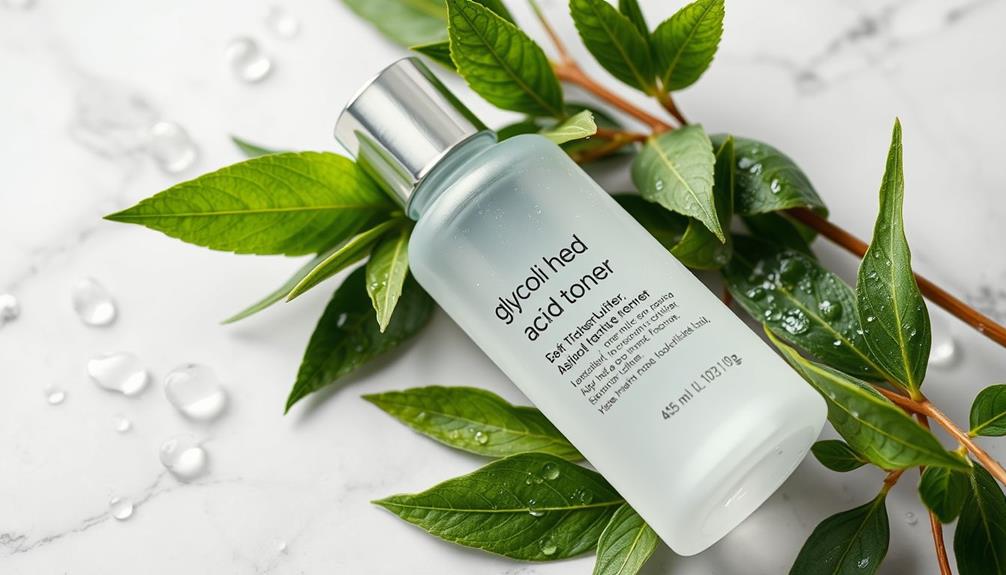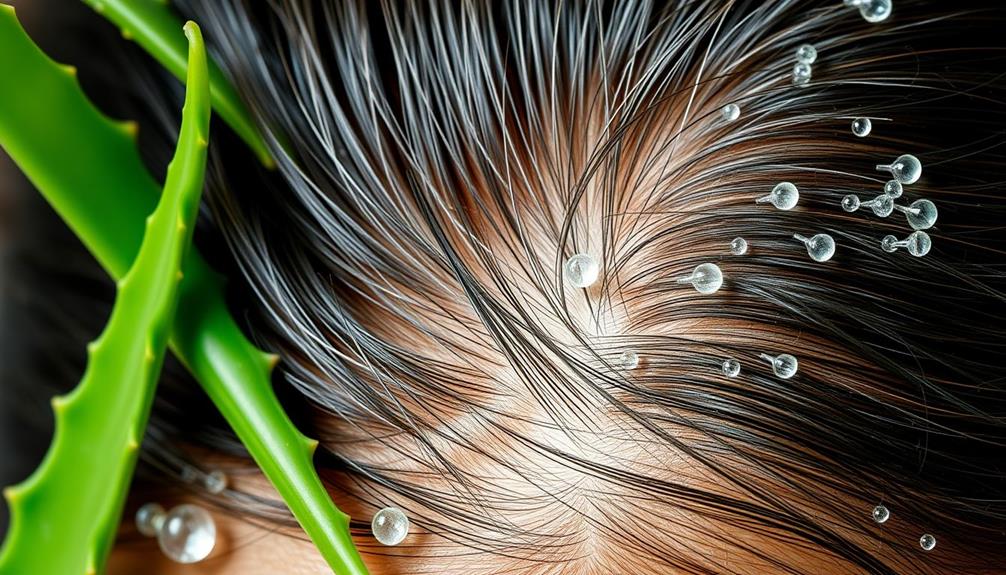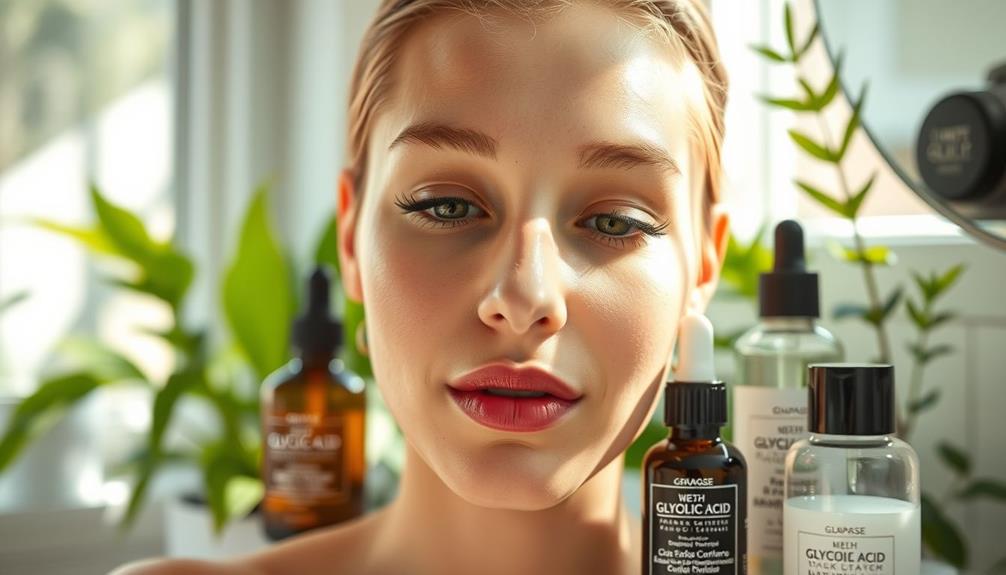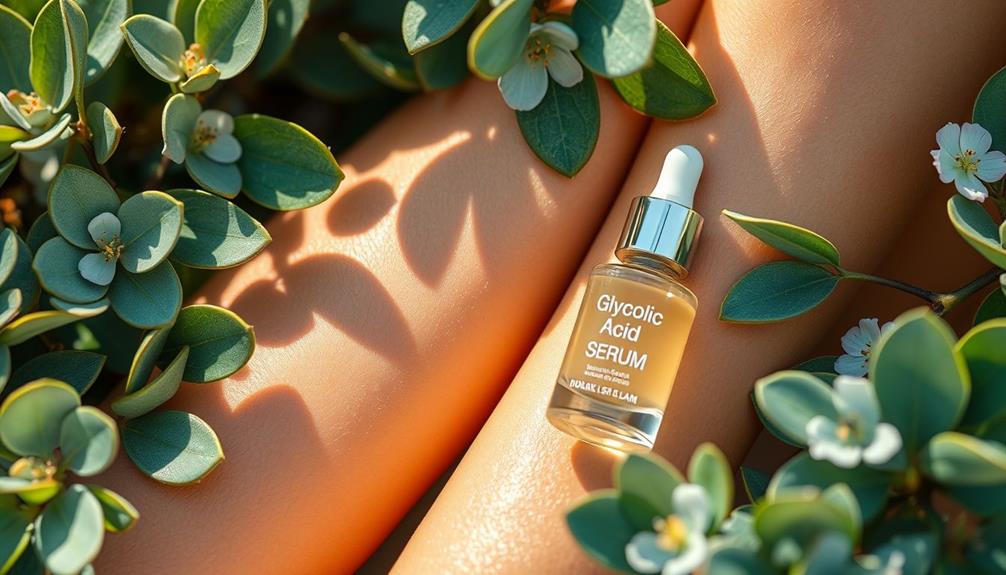Glycolic acid toner is your ultimate weapon against acne, thanks to its powerful exfoliating properties. This alpha-hydroxy acid penetrates deep into your skin, unclogging pores and promoting cell turnover. Regular use can reduce acne scars, fine lines, and hyperpigmentation while boosting collagen production for firmer skin. Start by applying it once or twice a week after cleansing, gradually increasing the frequency as your skin gets used to it. Remember to follow up with a moisturizer and sunscreen to protect your skin from irritation. There's much more to explore about maximizing your results with glycolic acid, so keep going!
Key Takeaways
- Glycolic acid toner effectively exfoliates skin, unclogs pores, and promotes hydration, reducing acne and improving skin texture.
- Regular use of glycolic acid stimulates collagen production, minimizing the appearance of scars and fine lines.
- Start with lower concentrations and gradually increase usage to prevent irritation while achieving clear skin.
- Pair glycolic acid with hydrating ingredients like hyaluronic acid and niacinamide for enhanced results and moisture retention.
What Is Glycolic Acid?
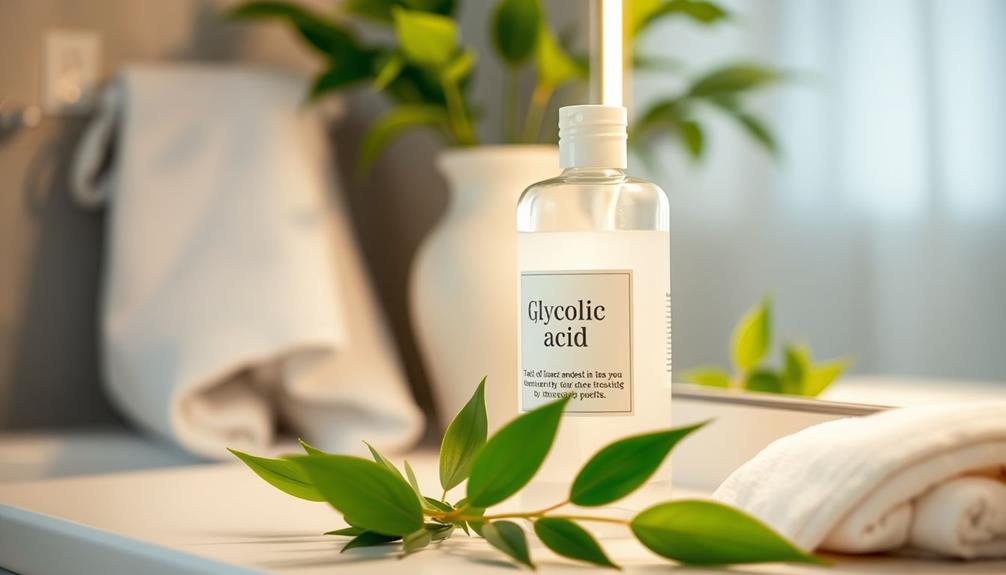
Glycolic acid is a powerful exfoliant derived from sugarcane that helps improve your skin's texture by removing dead skin cells.
As an alpha-hydroxy acid (AHA), it boasts unique exfoliating properties that make it particularly effective for oily and acne-prone skin. Its small molecular size allows glycolic acid to penetrate deeply, breaking down the bonds between dead skin cells and promoting cell turnover.
By incorporating family activities that promote creativity into your skincare routine—such as creating DIY masks or natural skincare products—you can engage in a more holistic approach to self-care.
By regularly using glycolic acid, you can reduce the appearance of acne scars, fine lines, and hyperpigmentation, revealing a brighter complexion.
This acid encourages your skin to regenerate new cells, enhancing overall skin texture and elasticity. Additionally, glycolic acid stimulates collagen production, which is essential for maintaining firmness and reducing the visible signs of aging.
Incorporating glycolic acid into your skincare routine can also help unclog pores and minimize excess oil, addressing common concerns associated with acne-prone skin.
Whether you're looking to smooth your skin or tackle specific blemishes, glycolic acid acts as an effective solution for achieving a clearer, healthier complexion.
Benefits of Glycolic Acid Toner
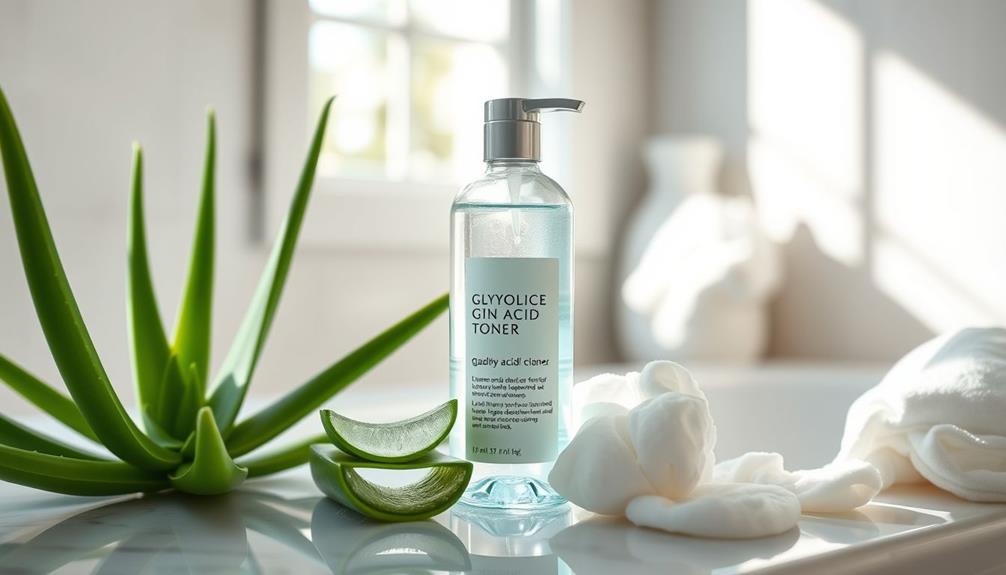
Using a glycolic acid toner can greatly enhance your skincare routine by providing multiple benefits that target acne and improve overall skin health. This powerful toner contains 7-10% glycolic acid, which effectively exfoliates dead skin cells and unclogs pores, leading to a clear complexion and reduced acne breakouts.
Moreover, regular use of glycolic acid toner promotes hydration and moisture retention, helping your skin feel plump and revitalized. It boosts collagen production, which is essential for maintaining a youthful appearance.
In addition to these benefits, glycolic acid toner helps minimize the appearance of acne scars and hyperpigmentation, promoting a more even skin tone. You'll also notice an improvement in skin texture, as it reduces the look of pores and fine lines, resulting in smoother skin overall.
| Benefit | Description |
|---|---|
| Exfoliation | Removes dead skin cells for a clearer complexion. |
| Hydration | Enhances moisture retention for plump skin. |
| Collagen Production | Stimulates collagen for youthful skin. |
| Reduces Acne Scars | Fades hyperpigmentation and promotes even skin tone. |
Incorporating glycolic acid toner into your regimen will elevate your skincare game!
How Glycolic Acid Works
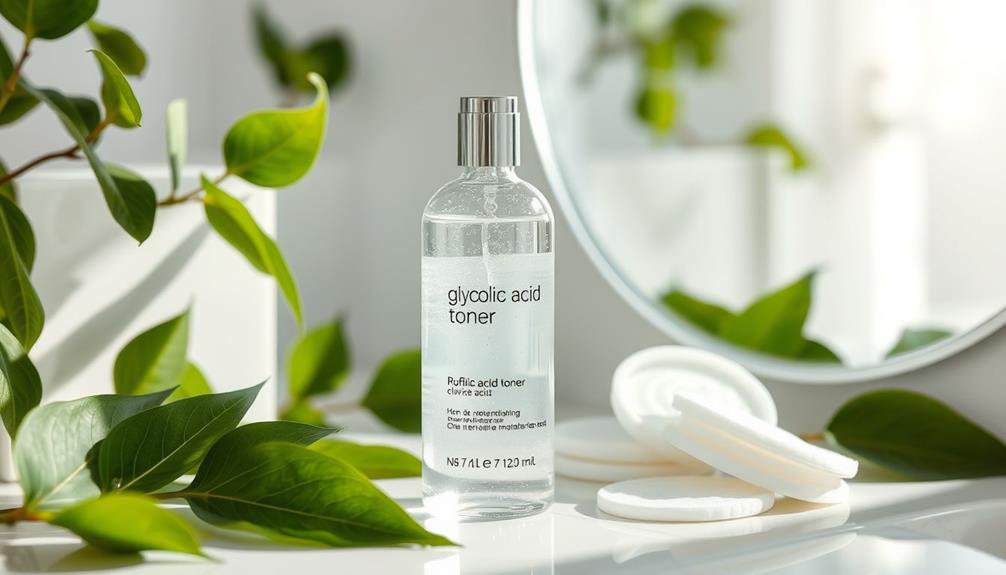
This small-molecule alpha-hydroxy acid (AHA) penetrates deeply into the skin, effectively dissolving the bonds between dead skin cells for smoother, brighter skin.
Glycolic acid promotes gentle exfoliation, which unclogs pores and helps reduce excess oil, a common culprit behind acne. By enhancing cell turnover, it accelerates the shedding of old skin cells, preventing them from accumulating and leading to breakouts.
Additionally, incorporating natural alternatives like essential oils for skin health can complement the effects of glycolic acid in your skincare routine.
In addition to its exfoliating properties, glycolic acid improves skin texture and elasticity by stimulating collagen production. This is particularly beneficial for those with acne scars or fine lines, as it helps create a more even and firm complexion.
Its antibacterial properties also target acne-causing bacteria, aiding in the prevention of future outbreaks.
Moreover, glycolic acid is moisture-retaining, which means it not only helps balance oily skin but also keeps it hydrated.
This unique combination of benefits makes glycolic acid an essential ingredient for anyone looking to achieve clearer, healthier skin. Glycolic acid works to exfoliate the skin, removing dead skin cells and promoting cell turnover, which helps to unclog pores and reduce the appearance of fine lines and wrinkles. In addition, its ability to increase collagen production helps to improve skin elasticity and firmness, resulting in a more youthful complexion. With all of these benefits, it’s no wonder that glycolic acid is often referred to as the ultimate skin smoother.
Application Tips for Best Results
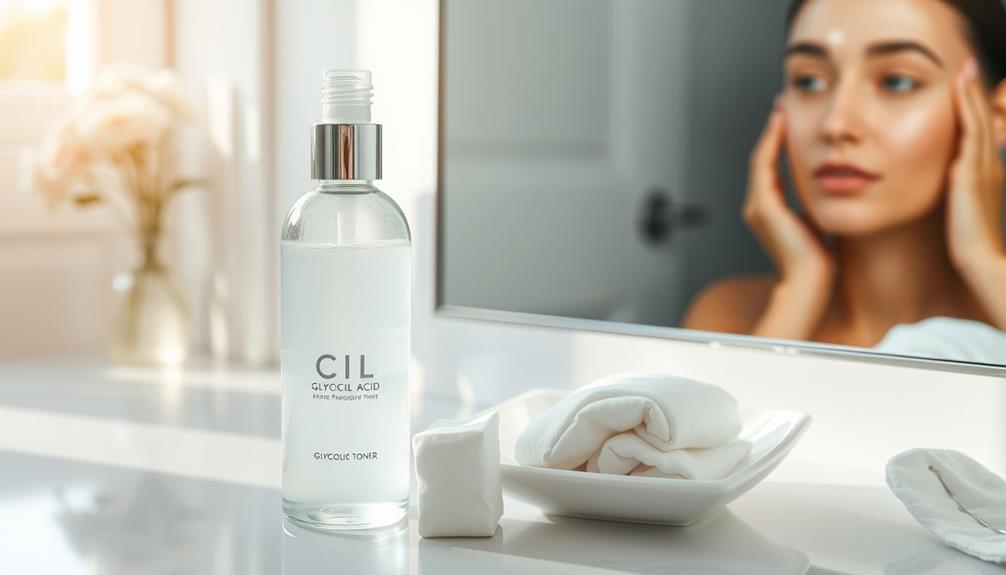
To get the most out of your glycolic acid toner, you need to prepare your skin properly and choose the right frequency of use.
It's beneficial to guarantee your skin is free from irritants, as certain scents and substances can affect your skin's reaction to treatments.
Additionally, understanding cat health and nutrition can be crucial when considering skin-friendly products for those with pets.
It's also vital to pair it with complementary products for ideal results.
Let's explore these key points to enhance your skincare routine.
Proper Skin Preparation
Start by cleansing your skin with a gentle cleanser to effectively remove makeup, oil, and dirt. Proper skin preparation is essential for maximizing the benefits of glycolic acid toner. After cleansing, pat your face dry with a clean towel to eliminate excess moisture that could dilute the toner's effectiveness.
Next, use a cotton pad or your hands to apply the glycolic acid toner evenly across your face, but remember to avoid the eye area to minimize irritation. Allow the toner to dry completely before layering any other products, as this helps it penetrate the skin for best results.
Finally, don't forget to follow up with a moisturizer to hydrate your skin and counteract any potential dryness caused by the toner's exfoliating properties.
| Step | Action |
|---|---|
| 1 | Cleanse with a gentle cleanser |
| 2 | Pat dry your face |
| 3 | Apply toner evenly |
| 4 | Moisturize after toner dries |
Frequency of Use
Using a glycolic acid toner effectively means starting with once or twice a week and adjusting based on how your skin reacts. The frequency of use is vital; begin slowly to gauge your skin tolerance. If your skin feels comfortable, you can gradually increase to three or four times a week. This consistent use can greatly improve skin texture and help reduce acne over time.
For best results, apply the toner in the evening. This evening application minimizes sun sensitivity, allowing your skin to recover overnight. Keep an eye on your skin reaction; if you notice any irritation, dial back the frequency or consider using a lower concentration product.
After applying the glycolic acid toner, always follow up with a moisturizer. This step is essential to hydrate your skin and mitigate any potential dryness or irritation caused by the toner.
Complementary Products
What products should you consider incorporating into your routine after applying a glycolic acid toner to maximize its benefits?
First, a hydrating serum containing hyaluronic acid is vital. This helps retain moisture and counteracts any dryness caused by the glycolic acid exfoliation.
Next, follow with a moisturizer that includes niacinamide. This combination enhances your skin's texture, minimizes the appearance of pores, and provides additional hydration.
Don't forget about sunscreen! Since glycolic acid increases sun sensitivity, daily broad-spectrum sunscreen is essential to prevent hyperpigmentation and protect your skin health.
Additionally, consider incorporating vitamin E or peptides into your routine. These ingredients offer extra moisture and anti-aging benefits, complementing the effects of glycolic acid without causing irritation.
Lastly, avoid using other strong exfoliants or retinoids at the same time. This can help minimize the risk of irritation, ensuring you maintain ideal skin health while enjoying the benefits of glycolic acid.
Understanding Concentrations and Products
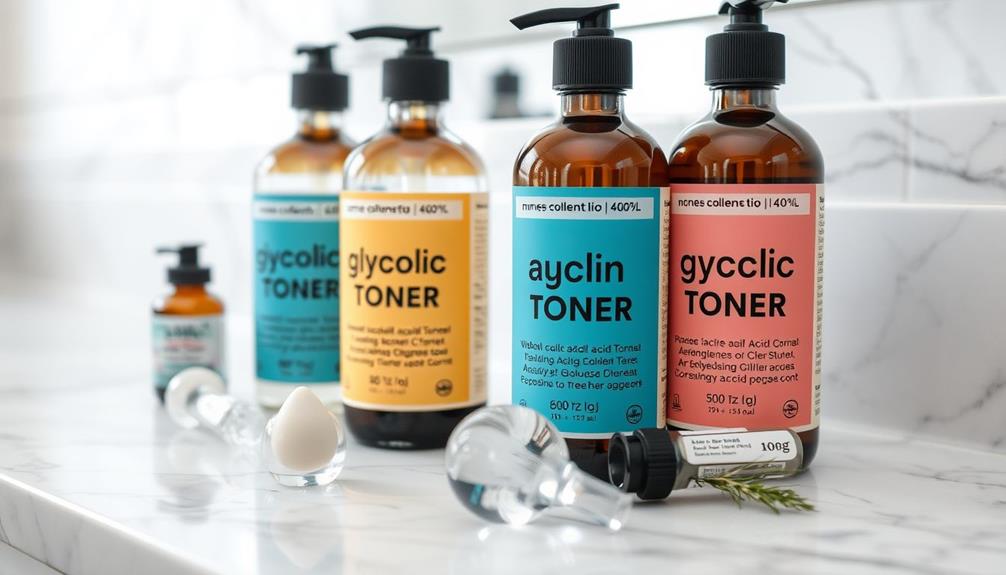
Glycolic acid toners come in various concentrations, typically ranging from 5% to 10% for over-the-counter options, while professional treatments can reach up to 50%. Understanding these concentrations is key to effective exfoliation and achieving desired results without overwhelming your skin.
Here are some important points to take into account:
- Start Low: If you have skin sensitivity, begin with a lower concentration to minimize irritation. Gradually increase as your skin builds tolerance.
- pH Matters: Look for toners with a pH between 3 and 4, ensuring effective exfoliation without excessive irritation.
- Hydration is Key: Choose products with hydrating ingredients like aloe vera or hyaluronic acid to combat dryness caused by glycolic acid.
- Sun Safety: Due to increased sun sensitivity, use glycolic acid toners in the evening and apply a broad-spectrum sunscreen during the day.
Common Side Effects and Precautions
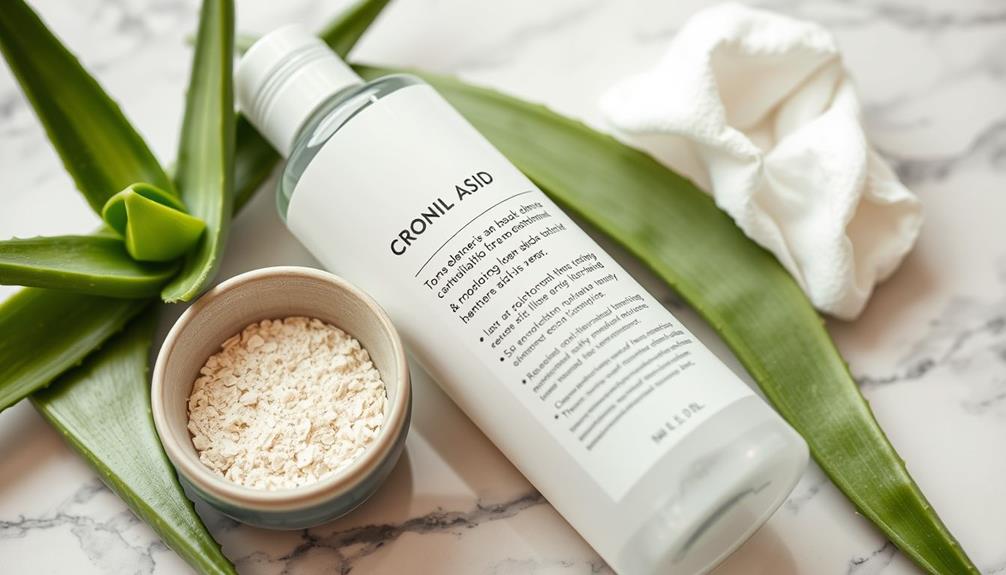
Common side effects of glycolic acid toner can include dryness, tingling, and irritation, especially for those with sensitive skin. To minimize these reactions, it's vital to gradually introduce the toner into your skincare routine. Start with lower concentrations, around 5-10%, and closely monitor your skin's response. If you experience significant skin irritation, consider reducing the frequency of use or switching to a milder product.
Another precaution involves sun sensitivity. Glycolic acid can increase your skin's vulnerability to UV damage, so applying a broad-spectrum sunscreen daily is important. This helps prevent hyperpigmentation and further skin issues.
If you notice persistent burning, swelling, or severe irritation, it's wise to discontinue the use of the toner immediately. Consulting a dermatologist may be necessary for ongoing reactions or if you're unsure about your skincare regimen.
Also, avoid combining glycolic acid with other strong exfoliants or retinoids, as this can heighten the risk of skin irritation and over-exfoliation. By taking these precautions, you can enjoy the benefits of glycolic acid toner while minimizing potential side effects.
Glycolic Acid Vs. Other Treatments
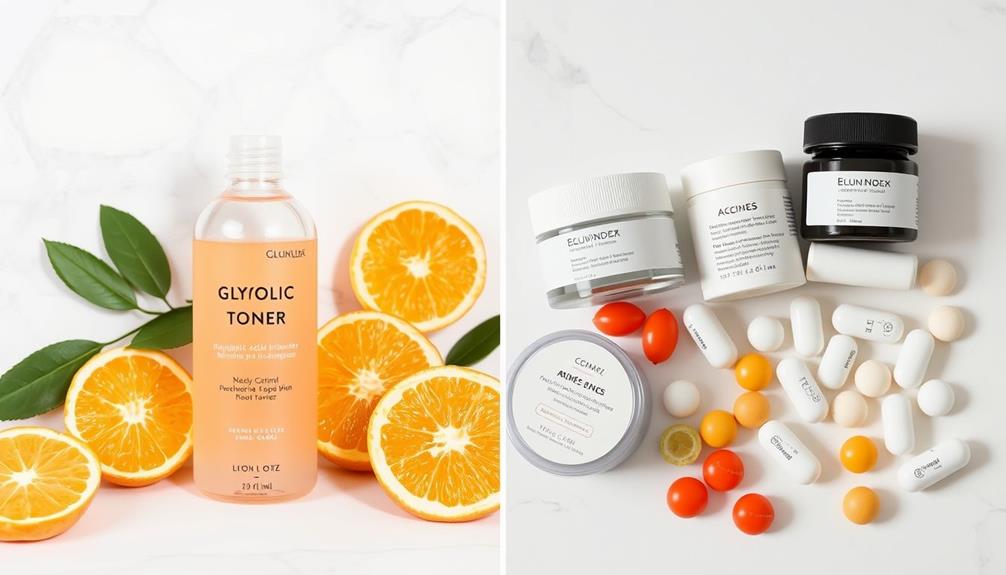
When choosing between glycolic acid and other treatments like salicylic acid or retinoids, it's important to evaluate your skin's needs.
Glycolic acid offers deeper exfoliation and improved texture, while salicylic acid excels at targeting active breakouts.
On the other hand, retinoids can be harsher, making glycolic a better option for those with sensitive skin.
Glycolic Acid Vs. Salicylic Acid
Both glycolic acid and salicylic acid offer unique benefits for treating acne, with each targeting different skin concerns effectively. Understanding how they differ can help you choose the right acne treatment for your skin type.
- Glycolic Acid: This chemical exfoliant is an alpha-hydroxy acid (AHA) that primarily works on the skin's surface, improving texture and addressing issues like fine lines and pigmentation.
- Salicylic Acid: As a beta-hydroxy acid (BHA), it penetrates pores to dissolve excess oil and unclog them, making it especially effective for oily and acne-prone skin types.
- Irritation Potential: Glycolic acid may cause more sensitivity and dryness, particularly at higher concentrations, while salicylic acid is generally better tolerated.
- Combination Benefits: Using both can maximize your acne treatment, as glycolic acid exfoliates the surface while salicylic acid clears deep-seated impurities.
Efficacy Compared to Retinoids
Glycolic acid stands out as a powerful option for treating acne, offering quicker results compared to retinoids, which typically require more time to show their full benefits. This alpha-hydroxy acid provides effective chemical exfoliation, unclogging pores and enhancing skin texture, making it particularly suited for those struggling with acne.
In fact, studies indicate that glycolic acid can greatly reduce acne lesions and improve overall skin appearance within just 4 to 12 weeks. Glycolic acid's smaller molecular size allows it to penetrate the skin more deeply and rapidly, delivering immediate effects on surface texture and brightness.
On the other hand, retinoids, with their larger molecules, may take longer to penetrate effectively. While both treatments can improve acne scars, glycolic acid excels at promoting immediate exfoliation. Retinoids, however, are renowned for their long-term benefits in collagen production and skin renewal.
Moreover, glycolic acid is often better tolerated by those with oily skin types, while retinoids may trigger initial dryness and irritation. Ultimately, if you're seeking faster results, glycolic acid might be your best bet against acne.
Incorporating Glycolic Acid in Your Routine

Introducing glycolic acid toner into your skincare routine can greatly enhance your skin's texture and clarity. To effectively incorporate this powerful exfoliant, follow these steps:
- Start Slow: Begin with a low concentration (5-7%) to assess your skin's tolerance. Gradually increase the concentration as needed.
- Evening Application: Use the toner at night with a cotton pad on clean skin, avoiding the eye area to minimize irritation.
- Hydration Matters: After applying glycolic acid, follow up with a hydrating moisturizer containing hyaluronic acid to maintain skin hydration and combat dryness from exfoliation.
- Sun Safety: Since glycolic acid can make your skin sensitive to the sun, daily application of broad-spectrum sunscreen is essential to protect against sun damage.
Consistent use of glycolic acid toner not only promotes cell turnover but also helps reduce the appearance of acne scars and blemishes. By integrating these steps into your routine, you'll pave the way for clearer, smoother skin while keeping your skin healthy and well-protected.
Professional Treatments and Guidance
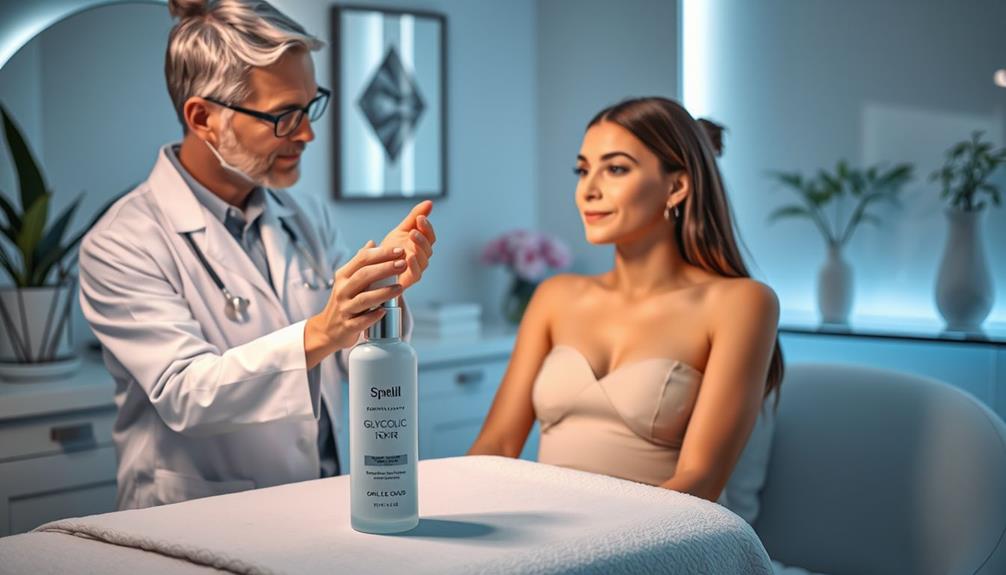
When considering glycolic acid treatments, you shouldn't overlook the importance of professional guidance.
Dermatologists can help you choose the right type of peel and monitor any risks associated with high concentrations.
This guarantees you receive safe and effective care tailored to your skin's needs.
Importance of Professional Guidance
Seeking professional guidance is crucial for effectively managing severe acne, as dermatologists can tailor treatment plans specifically to your skin's needs. With their expertise, you can better navigate the complexities of acne treatment and enhance your skincare journey. Here's why a consultation with a dermatologist is essential:
- Assessment of Skin Types: Dermatologists evaluate your unique skin type and conditions to guarantee the right product selection.
- Customized Treatment Regimen: They create a personalized treatment regimen that considers your specific concerns and goals.
- Minimizing Adverse Reactions: Professional guidance helps in choosing appropriate glycolic acid concentrations, reducing the risk of adverse reactions, particularly for those with darker skin tones.
- Ongoing Support: Regular follow-ups with your dermatologist allow for adjustments, guaranteeing ideal results and addressing any emerging skin issues promptly.
Incorporating the importance of professional guidance in your acne treatment can make a significant difference. By working closely with a dermatologist, you'll not only enhance the effectiveness of glycolic acid products but also foster a healthier, clearer complexion in the long run.
Types of Chemical Peels
Chemical peels are powerful professional treatments that use various acids, including glycolic acid, to effectively exfoliate your skin and address concerns like acne scarring and hyperpigmentation.
There are three main types of chemical peels: superficial peels, medium peels, and deep peels. Superficial peels, often using lower concentrations of glycolic acid, provide gentle exfoliation with minimal downtime and usually don't require anesthesia.
In contrast, medium and deep peels may involve higher concentrations of acids like trichloroacetic acid (TCA) or phenol, necessitating sedation and longer recovery periods. Superficial peels can be performed in a dermatologist's office, making them accessible for those looking to treat mild skin issues efficiently.
It's vital to consult with a dermatologist before undergoing any chemical peel, especially if you have darker skin tones. Higher concentrations can lead to increased irritation and hyperpigmentation, which is why professional guidance is essential.
Risks of High Concentrations
High concentrations of glycolic acid can pose significant risks, making it crucial to consult a qualified dermatologist for safe and effective treatment. Here are some critical considerations to keep in mind:
- Skin Irritation: High concentrations (over 20%) can lead to severe skin irritation, causing redness and discomfort.
- Acne Breakouts: Using strong glycolic acid peels may unexpectedly exacerbate acne breakouts, leading to further skin issues.
- Hyperpigmentation: Individuals with darker skin tones are at a higher risk for hyperpigmentation when using high concentrations of glycolic acid, requiring lower strengths and careful monitoring.
- Post-Care Guidelines: After treatment, you must adhere to professional post-care guidelines, including diligent sunscreen use to protect your skin from UV damage and increased sensitivity.
Glycolic acid treatments necessitate professional guidance to achieve the best chemical balance tailored to your skin type.
A dermatologist can guarantee that you receive the right concentration, reducing the likelihood of adverse effects.
Enhancing Results With Complementary Ingredients

Incorporating complementary ingredients like niacinamide and hyaluronic acid can greatly enhance the effectiveness of glycolic acid for acne-prone skin.
Niacinamide works wonders by improving skin texture, reducing the appearance of pores, and balancing oil production. When paired with glycolic acid, it creates a powerful duo that targets acne while promoting overall skin health.
Hyaluronic acid is essential for hydration, especially after the exfoliation process glycolic acid initiates. This ingredient can hold up to 1,000 times its weight in water, ensuring your skin remains moisturized and plump, counteracting any potential dryness from the acid.
Adding antioxidants, like vitamin E, can also boost the protective effects of glycolic acid, helping to combat oxidative stress.
If you're considering incorporating retinol, be mindful to use it at different times than glycolic acid; this combination enhances cell turnover for a smoother complexion but may cause irritation if used simultaneously.
Frequently Asked Questions
Does Glycolic Acid Toner Get Rid of Acne?
Yes, glycolic acid toner can help get rid of acne. It exfoliates your skin, unclogs pores, and balances oil production, leading to clearer skin and reduced breakouts over time with regular use.
What Happens if You Use Glycolic Acid Toner Everyday?
If you use glycolic acid toner every day, you might notice smoother skin and fewer blemishes. However, you could also face increased sensitivity and irritation, so be sure to introduce it gradually and wear sunscreen.
How to Use Glycolic Acid Toner for Acne?
To use glycolic acid toner for acne, cleanse your face first. Apply it with a cotton pad, start slow, and follow with a moisturizer. Always wear sunscreen during the day to protect your skin.
Can You Put Glycolic Acid on a Popped Pimple?
You shouldn't apply glycolic acid on a popped pimple right away. It can irritate the skin and delay healing. Wait until the area stabilizes to promote faster recovery and avoid discomfort.
Conclusion
In the battle against acne, glycolic acid toner stands as your secret weapon, transforming your skin from dull to dazzling.
While other treatments may offer temporary relief, glycolic acid penetrates deeper, delivering lasting results.
By incorporating it into your routine, you're not just treating breakouts—you're reclaiming your confidence.
So, say goodbye to frustration and hello to a clearer, radiant complexion.
With the right application and products, you'll unveil a new level of skincare success.
